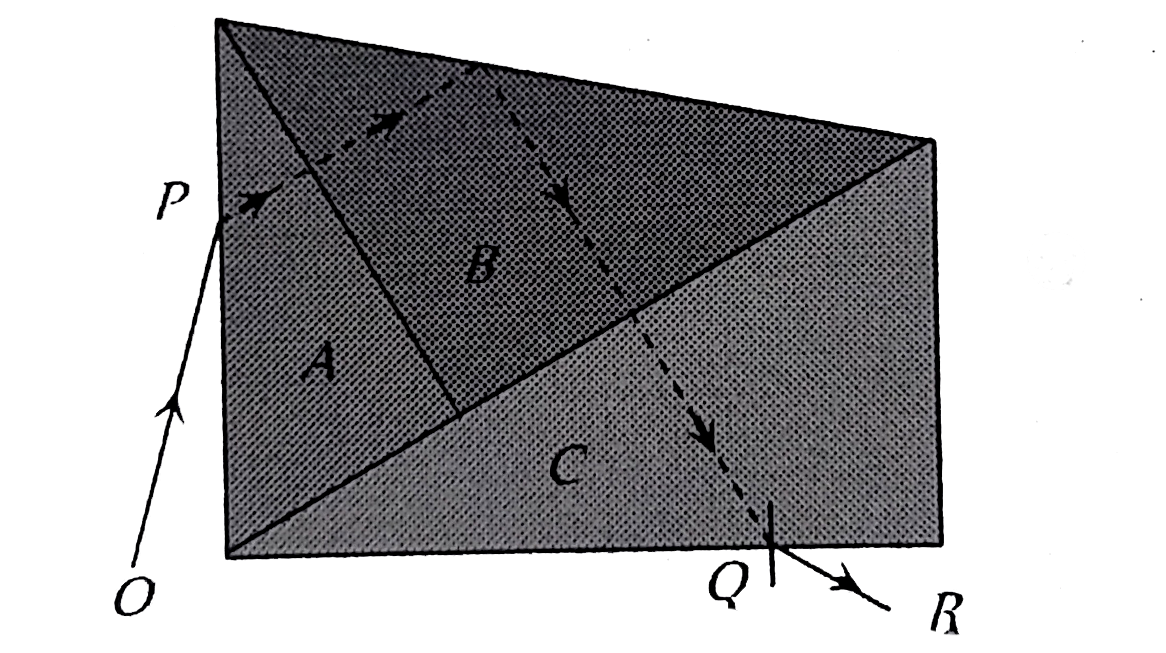Three glass prisms A , B and C of same refractive index are placed in contact with each other as shown in figure, with no air gap between the prisms. Monochromatic ray of light OP passes through the prism assembly and emerges as QR . The conditions of minimum deviation is satisfied in the prisms

A and C
B and C
A and B
In all prisms A, B and C
The correct Answer is:C
Step by step video, text & image solution for Three glass prisms A , B and C of same refractive index are placed in contact with each other as shown in figure, with no air gap between the prisms. Monochromatic ray of light OP passes through the prism assembly and emerges as QR . The conditions of minimum deviation is satisfied in the prisms by Physics experts to help you in doubts & scoring excellent marks in Class 12 exams.
Updated on:21/07/2023Topper's Solved these Questions
- RAY OPTICSBOOK - CENGAGE PHYSICSCHAPTER - RAY OPTICSEXERCISE - DPP 1.6
12 Videos
- RAY OPTICSBOOK - CENGAGE PHYSICSCHAPTER - RAY OPTICSEXERCISE - DPP 1.4
15 Videos
- PHOTOELECTRIC EFFECTBOOK - CENGAGE PHYSICSCHAPTER - PHOTOELECTRIC EFFECTEXERCISE - Integer Type
4 Videos
- RAY OPTICS AND OPTICAL INSTRUMENTSBOOK - CENGAGE PHYSICSCHAPTER - RAY OPTICS AND OPTICAL INSTRUMENTSEXERCISE - QUESTION BANK
40 Videos
Similar Questions
A parallel glass slab of refractive index √3 is placed in contact with an equilateral prism of refractive index √2. A ray is incident on left surface of slab as shown. The slab and prism combination is surrounded by air. The magnitude of minimum possible deviation of this ray by slab-prism combination is:

View SolutionRefraction of light through Prism| condition of maximum and minimum deviation|Dispersion of light through Prism
View Solution
Knowledge Check
Three glass prism A,B and C of same refractive index are placed in contact with each other as shown in figure, with no air gap between the prisms. Monochromatic ray of light OP passes through the prism assembly and emerges as QR. The conditions of minimum deviation is satisfied in the prisms.
 AA and CBB and CCA and BDIn all prisms A,B and C
AA and CBB and CCA and BDIn all prisms A,B and CMonochromatic light passes through a prism. Compared to that in air, inside the prism the light's
Aspeed and wavelength are different but frequency remains sameBspeed and frequency are different but wavelength remains same.Cwavelength and frequency are different, but speed remains same.Dspeed, wavelength and frequency are all differentMonochromatic light passes through prism. Compared to that in air. Inside the prism the light's
Aspeed and wavelength are different but frequency remains sameBspeed and frequency are different but wavelength remains sameCwavelength and frequency are different, but speed remains sameDspeed, wavelength and frequency are all different
Calculate the speed of light in the prism if a ray of light is passing through an equilateral triangular glass prism from air and undergoes minimum deviation when angle of incidence is 5/4th of the angle of prism.
View SolutionA glass prism of refractive index 1.5 and angle of prism 6∘ is put in contact with another prism of refractive index 1.6 when a ray of light is made incident on this combination normally then it emerges out undeviated. The angle of second prism will be
View SolutionDraw ray diagram showing refraction of monocromatic light through a glass prism and hence obtain the relation between refractive index (μ) of the prism and angle of minimum deviation.
View SolutionA glass prism of refractive index 1.5 is placed in water of refractive index 1.33. The minimum value of the angle of the prism so that it will not be possible to have any emergent ray is
View SolutionAssertion (A) : The refractive index of a prism depends only on the kind of glass of which it is made of and the colour of light.
(Reason): The refractive index of a prism depends upon the refracting angle of the prism and the angle of minimum deviation.
View Solution
